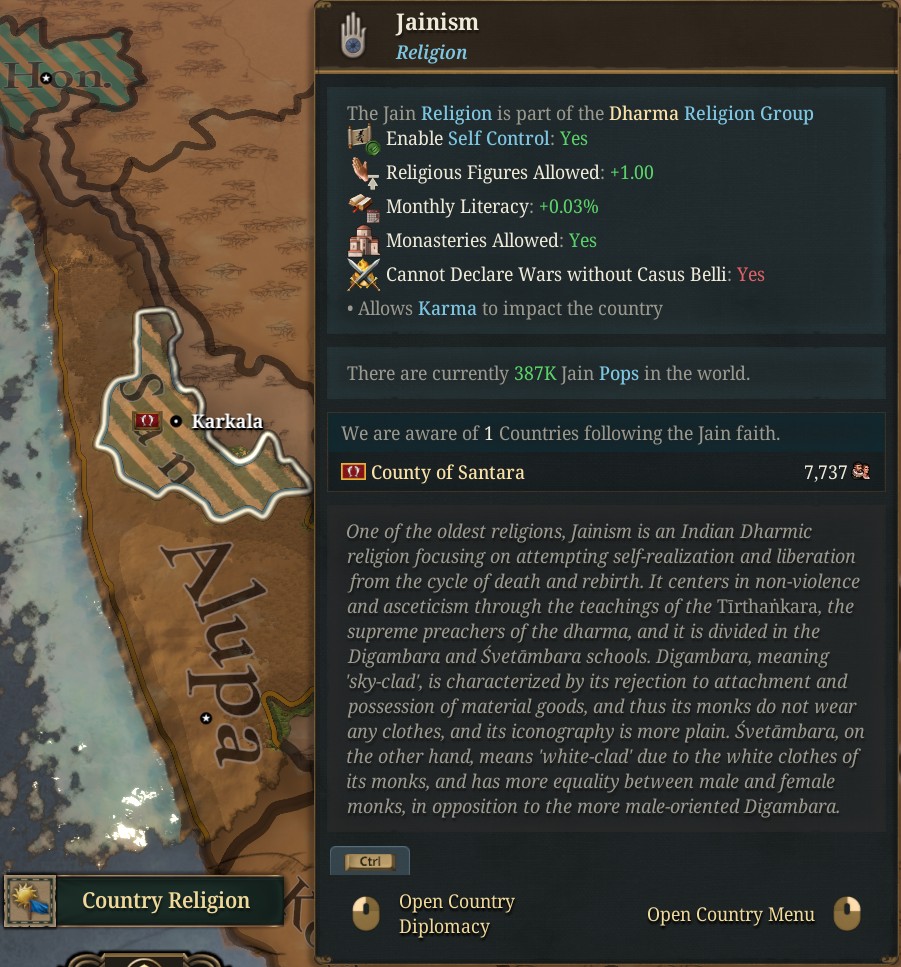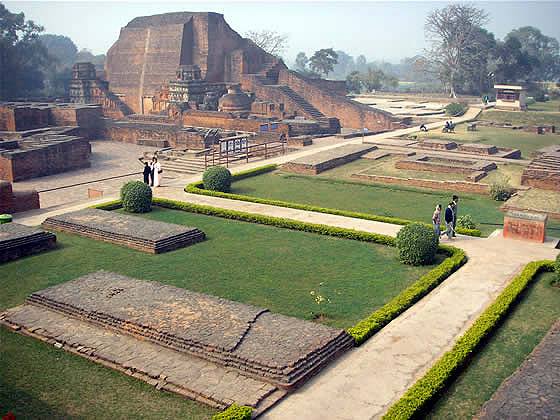Hello, and welcome to another Tinto Talks, the happy Wednesdays where we talk about Europa Universalis V!
Today, we will be taking a look at three of the religions born in India: Hinduism, Jainism, and Sikhism, which in the game are part of the Dharmic religion group:

As usual, take all UI, 2D and 3D art as WIP.
So let’s start by taking a look at the religious divide of India at the start of the game, in 1337:

We now have an interesting feature when in the religious map mode, as by hovering over a certain religion in the religious breakdown, you can check the religious spread and heatmap of that said religion. So let’s check Hinduism and Jainism, as both are present in 1337:


You also have these tooltips with the most important characteristics and the flavour of each religion, as we saw in previous Tinto Talks.
The first thing to talk about is the Hindu branches, which appear as an icon and action in the panel:

There are four branches in Hinduism, and each one is represented through an International Organization. Here you can see all:

When you click on a Hindu IO, each has its own panel:

In ‘Agenda’ (which is a common building block for different religions), you have a religious law set for each branch, that defines its mechanics:

This is the one for Vaishnavism:


Don't you love nested tooltips? Because we do!
It allows the country to activate as many as 3 Avatars of the god Vishnu, depending on having access to one of its holy sites:

And each avatar has different modifiers attached to it:



Shaivism:


You can gain or lose Self Control by performing these actions, and also some random events:





Shaktism:

This only allows you to have 1 Avatar active at any time of 10 possible, 5 in peace times and 5 in war times. By declaring war or stopping being at war makes you change from an avatar of one category to an avatar of the other. These avatars are randomly assigned, but you can change/reroll them using the Change Avatar action. The main difference with Vaishnavism is that you don’t need to have access to a holy site:




And Smartism:

In Smartism, you want to have all 5 gods favored equally, or otherwise they will give you negative modifiers. You can favor one over the others, though, to get more benefits from that one, at the cost of getting these negative modifiers from the others:





Jainism starts with interesting features, as seen in the previous tooltip, of which the disallowance to declare wars without a Casus Belli might be the most striking one, as portraying the peaceful and self-defensive nature of this religion. On top of that, they also have a kind of similar behavior to Shaivism, with the addition of the Karma mechanics on top of it:



Sikhism is a religion that is not present at the start of the game, but it will be able to appear after 1509 in a country that is either Hindu or Muslim, with locations of the other religion. If that happens, the following event will trigger:

That will not only enable the religion and convert some pops, but will also create a unique building, the Gurgaddi, to serve as the seat of a newly created building-based country led by the Guru himself. The second option of the event allows you to convert to the newly created religion, while the third option allows you to continue playing as the newly created Sikh country.




The new country will have a unique government reform, with a unique heir selection making it so that basically only the gurus are able to be the rulers of it.

When Sikhism appears, it will also create a new IO, and the first guru will cement its bases. There will be further events for each of the historical Sikh gurus, and each subsequent guru that appears will add to that IO, configuring the religion with further teachings.




A final common feature for all of them are Holy Sites. There are several different holy sites for all religions and (and branches, in the case of Hinduism):


These are examples of holy sites associated with the Vaishnavism branch of Hinduism.
And that’s all for today! We will continue taking a look at the Indian content this Friday, with a Tinto Flavour for the Sultanate of Delhi, and on Monday, with the Tinto Maps Feedback for the region of India. And next Wednesday, @SaintDaveUK will be hosting the Tinto Talks, with the topic being Unit Graphics. Cheers!
Today, we will be taking a look at three of the religions born in India: Hinduism, Jainism, and Sikhism, which in the game are part of the Dharmic religion group:

As usual, take all UI, 2D and 3D art as WIP.
So let’s start by taking a look at the religious divide of India at the start of the game, in 1337:

We now have an interesting feature when in the religious map mode, as by hovering over a certain religion in the religious breakdown, you can check the religious spread and heatmap of that said religion. So let’s check Hinduism and Jainism, as both are present in 1337:


You also have these tooltips with the most important characteristics and the flavour of each religion, as we saw in previous Tinto Talks.
Hinduism




The first thing to talk about is the Hindu branches, which appear as an icon and action in the panel:

There are four branches in Hinduism, and each one is represented through an International Organization. Here you can see all:

When you click on a Hindu IO, each has its own panel:

In ‘Agenda’ (which is a common building block for different religions), you have a religious law set for each branch, that defines its mechanics:

This is the one for Vaishnavism:


Don't you love nested tooltips? Because we do!
It allows the country to activate as many as 3 Avatars of the god Vishnu, depending on having access to one of its holy sites:
And each avatar has different modifiers attached to it:



Shaivism:


You can gain or lose Self Control by performing these actions, and also some random events:





Shaktism:

This only allows you to have 1 Avatar active at any time of 10 possible, 5 in peace times and 5 in war times. By declaring war or stopping being at war makes you change from an avatar of one category to an avatar of the other. These avatars are randomly assigned, but you can change/reroll them using the Change Avatar action. The main difference with Vaishnavism is that you don’t need to have access to a holy site:

And Smartism:

In Smartism, you want to have all 5 gods favored equally, or otherwise they will give you negative modifiers. You can favor one over the others, though, to get more benefits from that one, at the cost of getting these negative modifiers from the others:





Jainism

Santara is the only country that starts with Jainism as its state religion.

Santara is the only country that starts with Jainism as its state religion.
Jainism starts with interesting features, as seen in the previous tooltip, of which the disallowance to declare wars without a Casus Belli might be the most striking one, as portraying the peaceful and self-defensive nature of this religion. On top of that, they also have a kind of similar behavior to Shaivism, with the addition of the Karma mechanics on top of it:



Sikhism
Sikhism is a religion that is not present at the start of the game, but it will be able to appear after 1509 in a country that is either Hindu or Muslim, with locations of the other religion. If that happens, the following event will trigger:

That will not only enable the religion and convert some pops, but will also create a unique building, the Gurgaddi, to serve as the seat of a newly created building-based country led by the Guru himself. The second option of the event allows you to convert to the newly created religion, while the third option allows you to continue playing as the newly created Sikh country.




The new country will have a unique government reform, with a unique heir selection making it so that basically only the gurus are able to be the rulers of it.

When Sikhism appears, it will also create a new IO, and the first guru will cement its bases. There will be further events for each of the historical Sikh gurus, and each subsequent guru that appears will add to that IO, configuring the religion with further teachings.




A final common feature for all of them are Holy Sites. There are several different holy sites for all religions and (and branches, in the case of Hinduism):


These are examples of holy sites associated with the Vaishnavism branch of Hinduism.
And that’s all for today! We will continue taking a look at the Indian content this Friday, with a Tinto Flavour for the Sultanate of Delhi, and on Monday, with the Tinto Maps Feedback for the region of India. And next Wednesday, @SaintDaveUK will be hosting the Tinto Talks, with the topic being Unit Graphics. Cheers!






